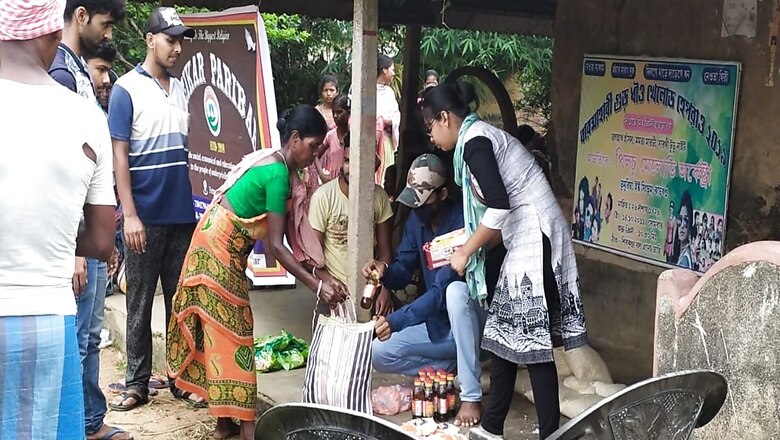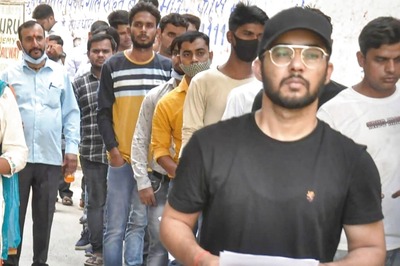
views
Water gushed into houses in Durbachati village of West Bengal on the night of May 26, causing irreparable damage and destruction, says Sheikh Sakiruddin. He was part of the relief work last year when Cyclone Amphan ravaged the state, destroying homes, lives and livelihood. This time, it was Cyclone Yaas, and Sakiruddin pitched in again.
“We are trying to stand by the people. However we need support and contributions from the public to help these villagers fulfil their basic needs,” he told News18.
Sakiruddin is part of a network of students and volunteers working across Bengal that has been invested in distributing ration kits and cooked meals to those hit by the double whammy of Covid-19 and Cyclone Yaas. Quarantined Student-Youth Network (QSYN), which took shape in 2020 to give aid to migrant workers amid the pandemic, expanded its operations after Amphan hit Bengal and began distributing tarpaulin and other materials required to rebuild homes in affected areas.
Cyclone Yaas lashed the country’s eastern coast on Wednesday, dumping heavy rain, damaging houses and farmlands, forcing lakhs of people out of their homes and leaving at least five dead in Bengal. Natural disasters have overrun the state several times in recent years, the volunteers say, and the onset of cyclonic storms has left many of those belonging to marginalised sections feeling vulnerable. As Yaas lashed West Bengal this time, QSYN says its volunteers and response team were ready as most of them were on standby since the devastation of Amphan last year.
Among those in need of help are refugees who were forced to migrate to the city of Kolkata after cyclones disrupted their means of income and wrecked homes. Having no place to go and forced to take up alternative sources of livelihood to feed their families, these people have been pushed to the brink once again by Yaas.
QSYN, which depends on public fundraising platforms to procure money, says it has been relentlessly working towards providing relief to these refugees.
PhD scholar in history and QSYN volunteer Debojit Kumar Thakur says that during Amphan, their network was not in a position to provide shelter to those left homeless. However, they reached 9,105 families across the districts of North 24 Parganas, South 24 Parganas, East Medinipur and Kolkata with tarpaulin to help repair their dwellings, he says.
“We were better prepared for Yaas. Our volunteers working at the People’s Kitchen in College Street, Kolkata, were able to shift most of the pavement dwellers in the area to the relative safety of the nearby Hare School on the night of 25th, before Yaas made landfall. These people are climate refugees in the city after Cyclone Aila (in 2009) and Amphan (in 2020) disrupted their means of income due to the salination of ponds, washing away of houses, bicycles and other equipment,” he said.
QSYN has so far distributed ration kits to 8,004 families and tarpaulin to 9,105 families, said Debojit.
“Furthermore, due to the general erratic nature of electricity in the affected areas, a condition heightened by Amphan, we decided to provide solar lamps so that 600 students could carry on their education with fewer interruptions. We also worked on initiatives to sanitise ponds designated for community use, in order to help restore the local economy,” he added.
Dr Saumitra Mohan, secretary (health) of West Bengal and director of the National Health Mission, this month approved the network’s application for carrying out Covid-management activities while adhering to necessary guidelines and advisories issued by the government. News18 has a copy of the memo.
QSYN is holding a fundraising event from May 28 to 30 with 95 eminent artistes from 14 countries, including filmmakers Anurag Basu and Shoojit Sircar, taking part to support Cyclone Yaas survivors.
The 2021 Global Report on Internal Displacement from Swiss agency Internal Displacement Monitoring Centre (IDMC) says Amphan that hit the coasts of India and Bangladesh on May 20 last year was a category 5 cyclone that triggered evacuations to the tune of 5 million, making South Asia account for almost a third of the world’s new disaster displacement in 2020.
In 2019, there were five million new disaster displacements in India, the highest in the world. Cyclone Fani in 2019 was the most powerful storm to strike the country in five years, and the most intense to form in the Bay of Bengal since 1999. Nearly two million people were displaced due to Fani. Another 289,000 people were evacuated in Gujarat in June 2019 ahead of Cyclone Vayu.
Read all the Latest News, Breaking News and Coronavirus News here. Follow us on Facebook, Twitter and Telegram.


















Comments
0 comment